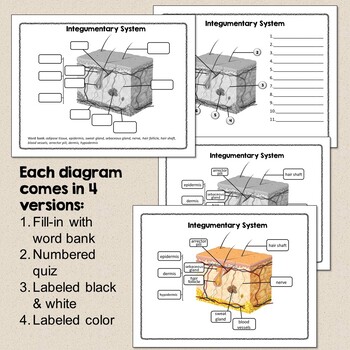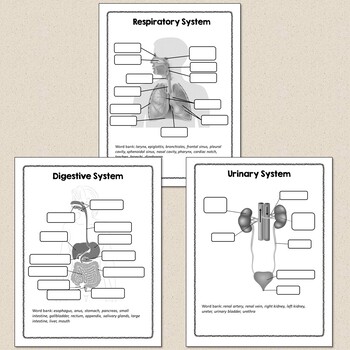Human Body Systems Diagrams, Worksheets, and Quizzes for Student Labeling
- PDF
Description
Diagrams and worksheets for student labeling of Integumentary, Skeletal, Muscular, Respiratory, Digestive, Endocrine, Cardiovascular, Lymphatic, Nervous, Urinary and Reproductive systems. This extensive set of 13 diagrams is perfect for human body quizzes, posters, or interactive notes!
Please note: This resource is also part of my Full Anatomy Curriculum.
Looking for more detailed diagrams and other structures for an Anatomy & Physiology or Health course? See my ADVANCED VERSION of these diagrams.
Labeling diagrams and scientific illustrations is a valuable way to assess student learning, reinforce concepts, and integrate previous knowledge.
This product contains FULL COLOR, detailed illustrations of the human body systems.
Each body system diagram worksheet comes in 4 versions:
1. Diagram with blanks for student labeling and a word bank
2. Diagram with numbered structures for quizzes or assessments
3. Diagram with labeled structures (For answer key or notes)
4. Color diagram with labeled structures (for notes, posters, or reference pages)
For details on specific diagrams or structures, click on the PREVIEW link above.
List of diagrams:
- Skin
- Common bones
- Common muscles
- Internal heart anatomy
- External heart anatomy
- Brain
- Lymphatic system anatomy
- Endocrine glands
- Respiratory system anatomy
- Digestive system anatomy
- Urinary system anatomy
- Male reproductive system anatomy
- Female reproductive system anatomy
This product is ideally designed for Life Science and Biology classes in grades 8-10, but could be used for Anatomy & Physiology classes as an introduction or beginning of the year review.
⭐For updates about sales and new products, please follow my store: My TpT Store
You can also
⭐Subscribe to my newsletter for freebies and teaching tips
⭐Follow me on Instagram
⭐Check out my Facebook page
⭐Follow me on Pinterest





